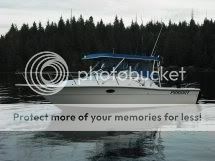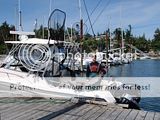H
Humpy
Guest
Im trying to research, what is leagal and what is not,, do you have to have them over a certain weight or not, what is best drum or disc..Thanks
The cheapest is the best. I find that launching in the salt water kills my breaks. Lucky to get 2 years out of the electrics.quote:Originally posted by Humpy
Im trying to research, what is leagal and what is not,, do you have to have them over a certain weight or not, what is best drum or disc..Thanks
quote:Check your owner’s manual to find your vehicle’s towing
capability. If you tow a load that is too heavy for your vehicle,
you create a potential safety risk for yourself and others on the road. Motor Vehicle Act Regulations in British Columbia prohibit the operation of vehicles that are unsafe or improperly loaded and exceed either the Gross Axle Rating (GAWR) or the Gross Vehicle Weight Rating (GVWR). The Province is focusing on vehicles that are obviously overweight and pose a risk to the safety of other motorists. These regulations apply to vehicles manufactured after January 1, 2001 that have a GVWR of 5500 kg or less.
Brake requirements
• All trailers & towing dollies (car dollies) must have brakes on all wheels when their GVW (trailer/dolly and load) exceeds 1,400 kilograms (3,086 pounds). Every trailer with brakes must have a breakaway device hooked to the trailer brake system.
- Surge brakes may be used when towing a vehicle that has a gross vehicle weight (GVW) of up to and including 2,800 kilograms (6,173 pounds).
- From 2,800 kilograms and up the towed-vehicle brakes must be able to be applied by the driver of the tow vehicle.
• Motorhomes (only) may tow motor vehicles via a tow bar without brakes hooked up on the towed motor vehicle, when the towed motor vehicle’s laden weight (weight of towed vehicle and its load) is:
- less than 2,000 kilograms (4,409 pounds), and
- less than 40 per cent of the gross vehicle weight rating (GVWR) of the motorhome towing it
• Motor vehicles with a laden weight of 2,000 kilograms and over towed by a motorhome must have brakes and breakaway device hooked up.
Preparing to tow
• The vehicle-on-tow must have valid licensing and insurance.
• Only one (1) trailer may be towed at a time (a car dolly with car are regarded as one trailer).
• All vehicles being towed via a ball hitch must have safety chain(s) or cable(s).
• A recreational vehicle towed via a 5th wheel hook-up does not require safety chains or cables.
• All vehicles being towed must have lights connected to the tow vehicle.
Maximum widths for Recreational Vehicles
• Maximum total overall width for recreational vehicles is 2.6 metres (8 feet 6 inches).
• Mirrors (only) may exceed the width of the vehicle by 20 centimetres (8 inches) on each side.
Maximum lengths for Recreational Vehicles
• Maximum total length for a motorhome is 14.0 metres (45.93 feet).
• Maximum length for a towed recreational vehicle is 12.5 metres (41 feet).
• Maximum overall length for a combination is 20.0 metres (65.6 feet).
More information
For more information on this and other matters related to recreational vehicles, visit our website at www.th.gov.bc.ca/cvse or contact your nearest weighscale/inspection station.
MV3230 (052007)
Information on this fact sheet is subject to change without notice. In the event of conflict with this fact sheet and the Motor Vehicle Act & Regulations, the acts and regulations shall apply.
Fact
Sheet
_____________
May 2007
Commercial Vehicle Safety and Enforcement Branch



